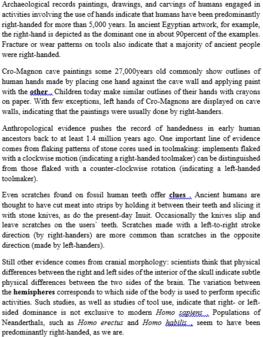Read the following passage and mark the letter A, B, C, or D on your answer sheet to indicate the correct answer to each of the questions from 35 to 42.
A newborn baby can see, hear and feel. By the age of five, a child can talk, ride a bike and invent imaginary friends. How does this development happen? We don't understand the way language, thinking and planning develop very well. Now scientists are using new technology to ‘see’ into children's brains. And they are discovering new information about the way a baby's brain develops.
A study in 2010 showed that the experiences a child has in their first few years affect the development of the brain. It showed that children who received more attention often had higher IQs. The brain of a newborn baby has nearly a hundred billion neurons. This is the same number as an adult's brain. As they grow, a baby receives information through the senses of sight, hearing, smell, taste and touch. This information creates connections between different parts of the brain. At the age of three, there are a hundred trillion connections.
One experiment looked at images of babies' brains while they were listening to different sounds. The sounds were in different sequences. For example, one sequence was mu-ba-ba. This is the pattern ‘A-B-B’. Another sequence was mu-ba-ge. This is the pattern ‘A-B-C’. The images showed that the part of the brain responsible for speech was more active during ‘A-B-B’ patterns. This shows that babies can tell the difference between different patterns. This experiment is interesting because sequences of words are important to grammar and meaning. Compare two sentences with the same words in a different order: ‘John killed the bear’ is very different from ‘The bear killed John.’ So babies are starting to learn grammatical rules from the beginning of life.
Researchers also know that babies need to hear a lot of language in order to understand grammar rules. But there is a big difference between listening to television, audio books or the internet, and interacting with people. One study compared two groups of nine-month-old American babies. One group watched videos of Mandarin Chinese sounds. In the other group, people spoke the same sounds to the babies. The test results showed that the second group could recognise different sounds, however the first group learned nothing. The scientist, Patricia Kuhl, said this result was very surprising. It suggests that social experience is essential to successful brain development in babies.
According to the first paragraph
A. most aspects of child development are understood quite well
B. some five-year-olds have imaginary friends
C. children use technology more these days.
D. technology has been used in children's brain surgery



Kiến thức: Đọc hiểu
Giải thích:
Theo đoạn đầu tiên
A. hầu hết các khía cạnh của sự phát triển của trẻ em được hiểu khá rõ.
B. một số trẻ năm tuổi có những người bạn tưởng tượng.
C. trẻ em sử dụng công nghệ nhiều hơn ngày nay.
D. công nghệ đã được sử dụng trong phẫu thuật não trẻ em.
Thông tin: By the age of five, a child can talk, ride a bike and invent imaginary friends.
Tạm dịch: Đến năm tuổi, một đứa trẻ có thể nói chuyện, đi xe đạp và nghĩ ra những người bạn tưởng tượng.
Chọn B